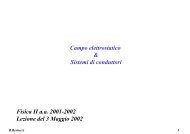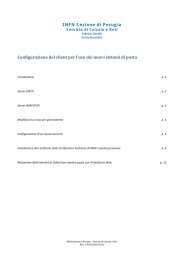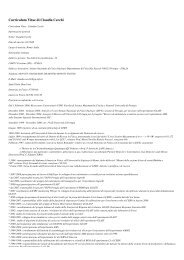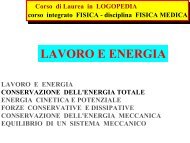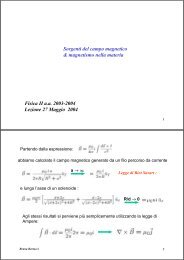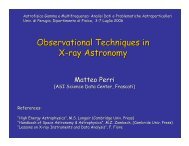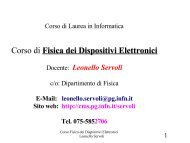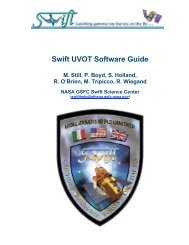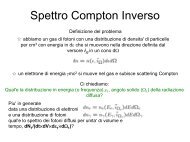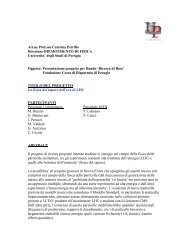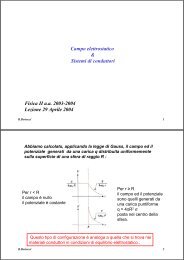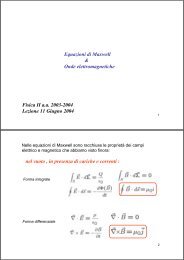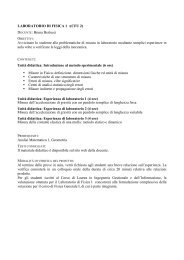Pulse (Energy) & Position Reconstruction in the CMS ECAL - INFN
Pulse (Energy) & Position Reconstruction in the CMS ECAL - INFN
Pulse (Energy) & Position Reconstruction in the CMS ECAL - INFN
You also want an ePaper? Increase the reach of your titles
YUMPU automatically turns print PDFs into web optimized ePapers that Google loves.
<strong>Pulse</strong> (<strong>Energy</strong>) & <strong>Position</strong> <strong>Reconstruction</strong> <strong>in</strong> <strong>the</strong><br />
<strong>CMS</strong> <strong>ECAL</strong><br />
(Testbeam Results from 2003)<br />
Ivo van Vulpen<br />
CERN<br />
On behalf of <strong>the</strong> <strong>CMS</strong> <strong>ECAL</strong> community
Calor 2004 (March 2004) Ivo van Vulpen 2<br />
The Compact Muon Solenoid dectector<br />
The H4 Testbeam at CERN<br />
supermodule<br />
R =129 cm<br />
Testbeam set-up <strong>in</strong> 2003:<br />
∆z = 6,410 cm<br />
Barrel = 61,200 crystals<br />
2 supermodules (SM0/SM1) have<br />
been placed <strong>in</strong> <strong>the</strong> beam (electrons)<br />
Front-end electronics:<br />
FPPA(100) /MGPA(50) crystals equippe
Calor 2004 (March 2004) Ivo van Vulpen 3<br />
Two testbeam periods <strong>in</strong> 2003<br />
Two sets of front-end electronics used: FPPA and MGPA<br />
<strong>the</strong> new 0.25 mm front-end electronics<br />
FPPA<br />
MGPA<br />
# ga<strong>in</strong>s 4 3<br />
SM (# equip. crys.) SM0 (100) SM1 (50)<br />
period long short<br />
Electron energies 20, 35, 50, 80, 120, 150, 180, 200 25, 50, 70, 100<br />
(GeV)<br />
(us<strong>in</strong>g PS heavy ion run)
Calor 2004 (March 2004) Ivo van Vulpen 4<br />
<strong>Pulse</strong> (<strong>Energy</strong>) <strong>Reconstruction</strong><br />
Part 1<br />
A s<strong>in</strong>gle pulse … and how to reconstruct it<br />
(some testbeam specifics & evaluate universalities <strong>in</strong> <strong>the</strong> <strong>ECAL</strong>)<br />
Optimiz<strong>in</strong>g <strong>the</strong> algorithm<br />
Results
A s<strong>in</strong>gle pulse<br />
Calor 2004 (March 2004) Ivo van Vulpen 5<br />
1) Photons detected us<strong>in</strong>g an APD<br />
amplitude<br />
S<strong>in</strong>gle pulse<br />
2) Signal is amplified<br />
S i<br />
3) Digitization at 40 MHz (each 25 ns)<br />
3(4) ga<strong>in</strong> ranges (Energies up to 2 TeV)<br />
4) 14 time samples available offl<strong>in</strong>e<br />
pedestal<br />
Time samples (25 ns)<br />
How to reconstruct <strong>the</strong> amplitude:<br />
=Analytic fit:<br />
In case of large noise -> biases for small pulses<br />
= Digital filter<strong>in</strong>g technique: Fast, possibility to treat correlated noise
Tim<strong>in</strong>g <strong>in</strong>formation<br />
Calor 2004 (March 2004) Ivo van Vulpen 6<br />
<strong>CMS</strong>:<br />
Electronics synchronous w.r.t LHC bunch cross<strong>in</strong>gs<br />
Testbeam: A 25 ns random offset/phase w.r.t <strong>the</strong> trigger<br />
Number of events<br />
Spread <strong>in</strong> Time of maximum response<br />
25 ns<br />
σ(E)/E (%)<br />
Resolution versus mismatch<br />
SM0/FPPA<br />
Normalised T max<br />
T max mismatch (ns)<br />
= Precision on Tmax: <strong>CMS</strong>: jitter < 1 ns Testbeam: < 1 ns (use 1 ns b<strong>in</strong>s)
<strong>Pulse</strong> <strong>Reconstruction</strong> Method<br />
Calor 2004 (March 2004) Ivo van Vulpen 7<br />
~<br />
A = ∑ wi • Si<br />
i<br />
Amplitude weights signal+noise<br />
= Weights computation requires knowledge of <strong>the</strong> average pulse shape<br />
= Optimal weights depend on assumptions on S i
<strong>Pulse</strong> <strong>Reconstruction</strong> Method<br />
Calor 2004 (March 2004) Ivo van Vulpen 8<br />
Average pulse shape<br />
F(t)<br />
How to extract <strong>the</strong> optimal weights:<br />
χ<br />
2<br />
= ( S − A×<br />
F)<br />
T<br />
Cov<br />
−1<br />
( S − A×<br />
F )<br />
Sample heights<br />
Amplitude<br />
Covariance Matrix<br />
Expected sample heights: F(t)<br />
<strong>in</strong>imize χ 2 w.r.t A<br />
assum<strong>in</strong>g<br />
No pedestal<br />
No correlations<br />
w<br />
i<br />
=<br />
∑<br />
i<br />
f<br />
(<br />
i<br />
f<br />
2<br />
i<br />
)<br />
= Tim<strong>in</strong>g: Def<strong>in</strong>e a set of weights for each 1 ns b<strong>in</strong> of <strong>the</strong> TDC offset<br />
= Knowledge of expected shape required: shape itself, tim<strong>in</strong>g <strong>in</strong>fo and ga<strong>in</strong> rati
<strong>Pulse</strong> Shape <strong>in</strong>formation: Average pulse shape<br />
Calor 2004 (March 2004) Ivo van Vulpen 9<br />
25 pulse shapes<br />
superimposed<br />
α<br />
= Analytic description of pulse shape:<br />
f ( t)<br />
=<br />
⎡t<br />
⎢<br />
⎣<br />
− (T<br />
T<br />
max<br />
− T<br />
peak<br />
peak<br />
α<br />
) ⎤<br />
⎥<br />
⎦<br />
e<br />
⎛ t-T<br />
-α<br />
⎜<br />
⎝ T<br />
max<br />
peak<br />
⎞<br />
⎟<br />
⎠<br />
T peak<br />
T max<br />
SM0/FPPA<br />
Time (*25 ns)<br />
Could also use digital representation<br />
Note:<br />
= Shapes (T peak<br />
, α) are similar for large sets of (all) crystals<br />
= T max<br />
: 2 ns spread <strong>in</strong> <strong>the</strong> T max<br />
for all crystals (we account for it)<br />
universal
Calor 2004 (March 2004) Ivo van Vulpen 10<br />
Optimization of parameters<br />
= Optimization depends on particular set-up.<br />
For <strong>the</strong> testbeam:<br />
How many samples<br />
Which samples<br />
= Treatment of (correlated) noise
Optimization of parameters for testbeam operation<br />
Calor 2004 (March 2004) Ivo van Vulpen 11<br />
total # samples<br />
ore samples:<br />
= Precision (depends on noise and a<br />
correct pulse shape description)<br />
ess samples:<br />
σ(E)/E (%)<br />
= Faster & smaller data volume<br />
= Reduce effects from pile-up & noise<br />
SM0/FPPA<br />
which samples<br />
= Variance on scales like sample<br />
heights Use largest samples<br />
Depend on TDC offset (decided per event)<br />
σ(E)/E (%)<br />
SM0/FPPA<br />
Use 5 samples<br />
Start at 1 sample before<br />
<strong>the</strong> expected maximum
Treatment of (correlated) Noise<br />
Calor 2004 (March 2004) Ivo van Vulpen 12<br />
The (correlated) noise that was present <strong>in</strong> 2003 is under <strong>in</strong>vestigation<br />
and is treated off-l<strong>in</strong>e:<br />
orrelations between samples: Extract Covariance matrix (pedestal run)<br />
χ<br />
2<br />
=<br />
( S<br />
−<br />
A×<br />
F)<br />
T<br />
Cov<br />
−1<br />
(<br />
S<br />
−<br />
A×<br />
F )<br />
Covariance Matrix<br />
Pedestals: Use pre-pulse samples and fit Ampl. and Pedestal simultaneously<br />
χ<br />
2<br />
=<br />
( S<br />
−<br />
A×<br />
F<br />
−<br />
P)<br />
T<br />
Cov<br />
−1<br />
(<br />
S<br />
−<br />
A×<br />
F<br />
−<br />
P)<br />
Pedestal<br />
An optimal strategy for this procedure is under <strong>in</strong>vestigation
F<strong>in</strong>al design of front-end electronics<br />
Results us<strong>in</strong>g MGPA electronics<br />
‘empty’ crystal<br />
SM1/MGPA<br />
σ(E)/E (%)<br />
SM1/MGPA<br />
4x4 mm 2 impact region<br />
prelim<strong>in</strong>ary<br />
= ‘No bias at small amplitudes<br />
= Noise » 50 MeV (per crystal)<br />
σ ( E)<br />
E<br />
=<br />
2.4 %<br />
E<br />
⊕<br />
142 MeV<br />
E<br />
⊕ 0.44<br />
%<br />
Calor 2004 (March 2004) Ivo van Vulpen 13
Calor 2004 (March 2004) Ivo van Vulpen 14<br />
Impact <strong>Position</strong> <strong>Reconstruction</strong><br />
Part 2<br />
Determ<strong>in</strong>ation of <strong>the</strong> ‘true’ impact po<strong>in</strong>t<br />
<strong>Reconstruction</strong> of <strong>the</strong> impact po<strong>in</strong>t (2 methods)<br />
Conclusions<br />
SM0 / FPPA
Precision on ‘true’ impact position<br />
A hodoscope system determ<strong>in</strong>es <strong>the</strong> e-trajectory (and impact po<strong>in</strong>t on crystal)<br />
370 mm<br />
2500 mm 1100 mm<br />
Per plane: 2 staggered layers<br />
with 1 mm wide strips<br />
Per orientation 4 po<strong>in</strong>ts:<br />
0.50 mm<br />
σ(x) = σ(y) = 145 µm<br />
1 mm<br />
1 mm<br />
0.04 mm<br />
Calor 2004 (March 2004) Ivo van Vulpen 15
Shower<br />
shape<br />
Incident electron<br />
Crystal size<br />
2.2 x 2.4 cm<br />
Cut-off distribution<br />
5x5 <strong>Energy</strong><br />
Matrix<br />
Impact on crystal centre: 82% <strong>in</strong> central crystal and 96% <strong>in</strong> a 3x3 matrix (use 3x3)<br />
General Idea:<br />
∑ i<br />
∑<br />
= The position of <strong>the</strong> crystal (η i<br />
,ϕ i<br />
) or (x,y)<br />
= Two methods us<strong>in</strong>g different weights: w =<br />
x<br />
=<br />
Calor 2004 (March 2004) Ivo van Vulpen 16<br />
w<br />
i<br />
i • i<br />
w<br />
i<br />
x<br />
i Ei<br />
or<br />
w<br />
i<br />
=<br />
w<br />
0<br />
⎛<br />
+ log⎜<br />
⎜<br />
⎝<br />
∑ j<br />
Ei<br />
E<br />
j
Calor 2004 (March 2004) Ivo van Vulpen 17<br />
Def<strong>in</strong><strong>in</strong>g THE position of <strong>the</strong> crystal:<br />
= Crystals are off-po<strong>in</strong>t<strong>in</strong>g and tilted by <strong>in</strong> h and j <strong>the</strong> characteristic position is<br />
energy dependent<br />
= Depth of shower maximum is energy dependent<br />
As an example: <strong>the</strong> balance po<strong>in</strong>t <strong>in</strong> X<br />
Side view<br />
<strong>Energy</strong> (ADC counts)<br />
Data 120 GeV<br />
Crystal centre<br />
Balance po<strong>in</strong>t<br />
Balance Po<strong>in</strong>t (mm)<br />
1.5 mm<br />
simulation<br />
electron<br />
Impact position (mm)<br />
<strong>Energy</strong> (GeV)
<strong>Reconstruction</strong> Method 1:<br />
L<strong>in</strong>ear weight<strong>in</strong>g<br />
w i = Ei<br />
Calor 2004 (March 2004) Ivo van Vulpen 18<br />
∆Y (reco.–true) mm<br />
uncorrected S-curve<br />
corrected S-curve<br />
E = 120 GeV<br />
Reconstructed (Y) mm<br />
σ=620µm<br />
Resolution versus<br />
impact position<br />
Corrected for<br />
beam profile<br />
st resolution:<br />
ose to crystal edge<br />
∆Y (reco.–true) mm<br />
Worst resolution: max. energy fraction <strong>in</strong> central crystal<br />
= Requires a correction that is f(E,η,ϕ)
Calor 2004 (March 2004) Ivo van Vulpen 19<br />
w<br />
i<br />
=<br />
w<br />
<strong>Reconstruction</strong> Method 2: Logarithmic weight<strong>in</strong>g<br />
0<br />
⎛<br />
+ log⎜<br />
⎜<br />
⎝<br />
∑ j<br />
Ei<br />
E<br />
j<br />
⎞<br />
⎟<br />
⎟<br />
⎠<br />
(all weights should be ‡ 0.)<br />
M<strong>in</strong>imal (relative) crystal energy <strong>in</strong>cluded <strong>in</strong> computation<br />
Optimal W 0 = 3.80 (m<strong>in</strong>. crystal energy is 2.24% of <strong>the</strong> energy conta<strong>in</strong>ed <strong>in</strong> <strong>the</strong> 3x3 matrix<br />
∆Y (reco.–true) mm<br />
uncorrected<br />
Reconstructed (Y) mm<br />
σ=700µm<br />
∆Y (reco.–true) mm<br />
Corrected for<br />
beam profile<br />
= Resolution is now more flat over <strong>the</strong> crystal surface<br />
= no correction needed that is f(E,η,ϕ)
Impact <strong>Position</strong> Resolution versus energy (x, y)<br />
Calor 2004 (March 2004) Ivo van Vulpen 20<br />
Resolution on impact position us<strong>in</strong>g <strong>the</strong> logarithmic weight<strong>in</strong>g method:<br />
Resolution(mm)<br />
Hodoscope contribution subtracted<br />
1 mm<br />
Y-orientation<br />
= Resolution <strong>in</strong> X slightly worse:<br />
Different stagger<strong>in</strong>g of crystals<br />
Different crystal dimensions<br />
10% larger <strong>in</strong> X than <strong>in</strong> Y<br />
Different (effective) angle of<br />
<strong>in</strong>cidence<br />
<strong>Energy</strong> (GeV)<br />
σ 5040<br />
( µ Y<br />
m) = ⊕<br />
E<br />
430
Calor 2004 (March 2004) Ivo van Vulpen 21<br />
Conclusions<br />
= <strong>Pulse</strong> (<strong>Energy</strong>) reconstruction:<br />
<strong>ECAL</strong> strategy to reconstruct pulses <strong>in</strong> <strong>the</strong> testbeam set-up evaluated<br />
Optimized and exist<strong>in</strong>g ‘universalities’ are implemented.<br />
<strong>Energy</strong> resolution reaches target precision us<strong>in</strong>g <strong>the</strong> designed<br />
0.25 mm front-end electronics<br />
= Impact po<strong>in</strong>t reconstruction:<br />
Evaluated two approaches and extracted resolutions us<strong>in</strong>g real data<br />
Above 35 GeV: σ X<br />
& σ Y<br />
< 1 mm
Backup slides<br />
Calor 2004 (March 2004) Ivo van Vulpen 22
A<br />
pure signal<br />
f(t)<br />
A<br />
signal + rema<strong>in</strong><strong>in</strong>g pedestal<br />
Ped<br />
w<br />
i<br />
=<br />
∑<br />
i<br />
f<br />
(<br />
i<br />
f<br />
2<br />
i<br />
)<br />
wi = fi<br />
γ =<br />
( λ + γ<br />
Calor 2004 (March 2004) Ivo van Vulpen 23<br />
λ<br />
−1<br />
=<br />
∑ ( f<br />
i<br />
− λ<br />
n<br />
2<br />
i<br />
∑<br />
i<br />
)<br />
) −<br />
( )<br />
2<br />
fi<br />
∑<br />
i<br />
fi<br />
n samples<br />
/<br />
n



